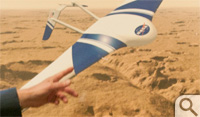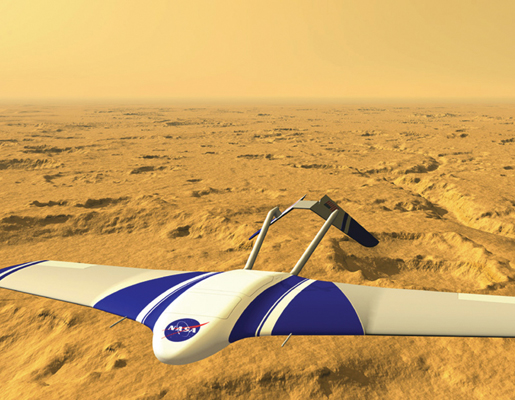Airplane over the Red Planet
A W&M-based Mars mission could happen, if everything goes right
William & Mary might become the base for a mission to Mars.
The mission is called ARES—the Aerial Regional-scale Environmental Surveyor. Joel Levine explains that the idea is to send an airplane to Mars.
Here’s the plan: The Mars flyer will begin its mission as payload on an Atlas launch vehicle, travel hundreds of million miles from the Earth to Mars, enter the atmosphere of Mars at a speed of about 18,000 miles per hour, then parachute down to near the surface of the Red Planet, unfolding on the way and beginning its historic flight—the first flight of an airplane on another planet. Once deployed, the robotic, rocket-powered craft will obtain observations that will yield new and important insights into some of Mars’ greatest mysteries, such as a strange, unexplained area of high magnetism and the source of the methane found in the Martian atmosphere.
If selected for the mission, federal funding in the neighborhood of $500 million would be needed to support the ARES project, not counting the $150 million dollar Atlas launch vehicle.

It’s already been tested
For the ARES project to happen, a lot of things have to go right, but Levine stresses that it’s not as much a long shot as you might imagine. For one thing, ARES is substantially designed and tested, including sessions in the wind tunnels at NASA Langley. The flyer also has been tested in the Earth’s atmosphere at an altitude of over 100,000 feet (about 20 miles high), where the density and pressure of the Earth’s atmosphere is comparable to the density and pressure of the Mars atmosphere near the surface, where ARES will fly.
For another thing, Levine says that NASA already likes the project. About 10 years ago, ARES was on a short list of four potential future NASA Mars missions, but NASA selected Phoenix, a stationary lander developed by the University of Arizona.
“They got really close,” said Mark Hinders, chair of William & Mary’s Department of Applied Science. “I happened to have been driving across Ohio at the time on my way back from a conference and I heard Joel on NPR talking about the Mars airplane.”
Return to William & Mary
In July 2011, Levine returned to William & Mary as a research professor in the Department of Applied Science after a long career (“41 years and one day”) at NASA. He started teaching at the College in 1990—while still working at NASA Langley—setting up a graduate-level program in atmospheric science within applied science.
His colleagues at NASA Langley and NASA headquarters in Washington urged Levine to continue to pursue the ARES mission from his new base at William & Mary. He is developing a proposal for the Mars airplane, to be submitted by William & Mary in conjunction with NASA Langley.
“NASA really likes university-led space missions,” Levine said. “The College is a natural partner for a NASA Langley collaboration on a mission to Mars due to its proximity to the Hampton research center and the College’s strong programs and abundant students in applied science, physics, chemistry, geology, biology and computer science—all very relevant areas of expertise for a mission to Mars.”
He explained that involving university undergraduate and graduate students in NASA missions is an excellent opportunity to inspire and develop the next generation of scientists and engineers for NASA recruitment. In addition, working on a NASA mission provides undergraduate and graduate students with opportunities to pursue master’s and doctoral dissertations by conducting state-of-the-art science and engineering research. In spring 2012, Levine has two geology undergraduates working on ARES-related research for their senior theses.
Levine says he anticipates the announcement of opportunity to propose ARES and other Mars missions for funding will come no earlier than mid-2013. The chances of the ARES Mission are difficult to predict, Levine says—if NASA funds any Mars missions at all. “NASA’s funding for planetary missions is in flux,” he notes.
Competing against orbiters, landers and rovers
In NASA’s judging, ARES will compete against unmanned Martian orbiters, landers and rovers, but Levine points out that a flyer offers a number of advantages. To begin with, a flyer is best way to investigate a mysterious region on Mars that has the strongest surface magnetic field of any planet in the solar system. Levine notes that the National Academy of Sciences has listed the discovery of this ultra-strong magnetic region as one of the five most important discoveries of the space age.
“We don’t know what causes the very intense magnetic field on the planet’s surface. We don’t know what it looks like,” Levine said. “It’s in a highland area. There are a lot of mountains, a lot of craters, and a lot of canyons in this region of Mars. We just cannot put a rover down in that area; the terrain is too rough for a safe landing. There is no way you can investigate and find out the source of this surface magnetism, other than an aerial platform, an airplane.”
He said ARES could also be used to investigate the 2009 discovery of methane in the atmosphere of Mars. In the Earth’s atmosphere, methane is produced mainly by biological activity. The third area of study is potentially vital for human missions to Mars—a scientific goal embraced as a national goal by the past two presidential administrations.
“We want to
study the concentration and distribution of frozen water below the surface of
Mars,” he said. “We have an instrument called neutron spectrometer that can
make subsurface measurements of frozen water. That’s very important because
when we send humans to Mars, it’s going to take nine months to get there, nine
months to come back—and then the astronauts will spend 500 days on the surface.
You can’t take enough water to supply the needs of the crew for such a long
trip and visit on Mars.” ![]()
















